In the past two weeks, North Korea has fired four test missiles, two of which were from an airport in Pyongyang on Friday, January 14, according to a South Korean military statement. Josh Smith, writing for Reuters, said the Kim Jong Un government’s tests “demonstrate its expanding missile arsenal.” Nonetheless, the number and frequency of tests are unusual. North Korea’s testing is prohibited by U.N. Security Council resolutions. To quote Japanese Defense Minister Nobuo Kishi, “The repeated launching of North Korea’s ballistic missile is a grave problem for the international community, including Japan.”
 In the past, North Korea conducted such tests to commemorate significant dates in the country’s history or as a protest targeting a U.S.-South Korea exercise; these more recent actions seem to be motivated by other reasons. One of those may be Kim’s desire to project the appearance of Pyongyang’s steadfast dedication to developing its military capability despite internal hardships. Ankit Panda, a subject matter expert with the Carnegie Endowment for International Peace, told the BBC: “Kim Jong Un also has domestic considerations: at a time of economic difficulty, these launches allow him to convey that national defense priorities will not fall by the wayside.” Additionally, in keeping with Kim’s desire to be in the geopolitical limelight, the recent international problems in Ukraine and Kazakhstan have shone the spotlight elsewhere. As a result, these launches put the focus back on North Korea’s leader.
In the past, North Korea conducted such tests to commemorate significant dates in the country’s history or as a protest targeting a U.S.-South Korea exercise; these more recent actions seem to be motivated by other reasons. One of those may be Kim’s desire to project the appearance of Pyongyang’s steadfast dedication to developing its military capability despite internal hardships. Ankit Panda, a subject matter expert with the Carnegie Endowment for International Peace, told the BBC: “Kim Jong Un also has domestic considerations: at a time of economic difficulty, these launches allow him to convey that national defense priorities will not fall by the wayside.” Additionally, in keeping with Kim’s desire to be in the geopolitical limelight, the recent international problems in Ukraine and Kazakhstan have shone the spotlight elsewhere. As a result, these launches put the focus back on North Korea’s leader.

Additionally, as The Guardian’s Justin McCurry reported, “The North has, however, demonstrated advances in its weapons technology with tests of ‘hypersonic missiles’ capable of high speeds and maneuvering after launch, making them harder to detect and intercept. On Friday [January 14], the regime fired a pair of short-range missiles from train cars.” McCurry explained that Japan’s chief cabinet secretary, Hirokazu Matsuno, responded to the launches with, “We strongly condemn the series of North Korean actions, including the repeated launches of ballistic missiles, that threaten the peace and security of Japan and the region, and the international community.” Located within a 621-mile range of Pyongyang’s hypersonic missiles traveling at nearly five times the speed of sound (3,580 MPH), the Tokyo government has a legitimate concern with North Korea’s testing program.
Zhao Lijian, China’s foreign ministry spokesman, cautioned: “We call on relevant sides to keep in mind the overall peace and stability on the peninsula.” Since Kim’s technology no doubt came with help from the People’s Republic of China (PRC), the warning seems disingenuous. Beijing could do more to rein in the rogue nation on its northeastern border. Regardless, tensions are high on the Korean peninsula as Kim’s government threatened a “stronger and certain reaction” should more sanctions appear from the United States in response to the missile tests, according to The New York Times’ Choe Sang-Hun. Additionally, any increase in international stress in the region is unwelcome as China prepares for the Winter Olympics in Beijing in February and South Korea is “gearing up for its presidential election on March 9.”
 Since September, when North Korea began its testing program after a six-month stand-down, the Kim regime has conducted six tests, including submarine-launched ballistic missiles, mobile ballistic missiles mounted on train cars, and a long-range strategic missile. Of the four in the last month, Pyongyang claimed two were “hypersonic ballistic missiles” with at least one fired on January 11, 2022. Though no reporting has provided details on the high velocity weapons, it is not likely they are as sophisticated as the one launched by the PRC last August.
Since September, when North Korea began its testing program after a six-month stand-down, the Kim regime has conducted six tests, including submarine-launched ballistic missiles, mobile ballistic missiles mounted on train cars, and a long-range strategic missile. Of the four in the last month, Pyongyang claimed two were “hypersonic ballistic missiles” with at least one fired on January 11, 2022. Though no reporting has provided details on the high velocity weapons, it is not likely they are as sophisticated as the one launched by the PRC last August.
However, one element of the North Korean missile program is particularly troubling. Many are mounted on rail cars moving in and out of tunnels dug deep into the sides of mountains. Destroying these mobile missiles before they are fired is extremely difficult. Once identified and targeted, they may be miles away and already in position.
The Biden administration has a lot on its foreign policy plate. Russia’s menacing troop deployment on Ukraine’s border, the uprising in Kazakhstan, and China’s perpetual mischief-making in the Pacific region combine to make for a challenging geopolitical menu. Historically, the North Korean leadership has not been shy in menacing the West. Consequently, the rogue state – with its nuclear capability and variety of missiles to deliver warheads toward the U.S. and its allies – is formidable. The Biden foreign policy team cannot let anything Pyongyang does slip by.
The views expressed are those of the author and not of any other affiliation.
~ Read more from Dave Patterson.




